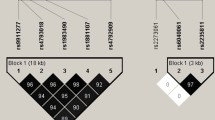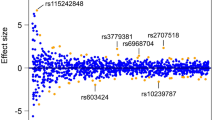Abstract
Summary
Replication is a critical step to validate positive genetic associations. In this study, we tested two previously reported positive associations. The low density lipoprotein receptor-related protein 5 (LRP5) Val667Met and lumbar spine bone density are replicated. This result is in line with results from large consortiums such as Genomos. However, the estrogen-related receptor alpha (ESRRA) repeat in the promoter is not replicated although the polymorphism studied was functional and could have been a causative variant.
Introduction
We sought to validate associations previously reported between LRP5 V667M polymorphism and lumbar spine (LS, p = 0.013) and femoral neck (FN, p = 0.0002) bone mineral density (BMD), and between ESRRA 23 base pair repeat polymorphism and LS BMD (p = 0.0036) in a sample of premenopausal Caucasian women using an independent sample.
Methods
For the replication sample, we recruited 673 premenopausal women from the Toronto metropolitan area. All women were Caucasian and had BMD measured. LRP5 V667M was genotyped by allele-specific PCR and ESRRA repeats by sizing of PCR products on agarose gels.
Results
We reproduced the same association as we reported previously between LRP5 V667M and LS BMD (p = 0.015) but not with FN BMD (p = 0.254). The combined data from the two populations indicate an effect size of 0.28SD for LS BMD (p = 0.00048) and an effect size of 0.26 SD for FN BMD (p = 0.00037). In contrast, the association we reported earlier between ESRRA repeats and LS BMD was not replicated in the sample from Toronto (p = 0.645).
Conclusions
The association between LRP5 V667M and LS BMD is confirmed but not that between ESRRA repeats and LS BMD. This result indicates that it is imperative to validate any positive association in an independent sample.
Similar content being viewed by others
References
Pocock NA, Eisman JA, Hopper JL et al (1987) Genetic determinants of bone mass in adults. A twin study. J Clin Invest 80:706–710
Brown LB, Streeten EA, Shapiro JR et al (2005) Genetic and environmental influences on bone mineral density in pre- and post-menopausal women. Osteoporos Int 16:1849–1856
Danielson ME, Cauley JA, Baker CE et al (1999) Familial resemblance of bone mineral density (BMD) and calcaneal ultrasound attenuation: the BMD in mothers and daughters study. J Bone Miner Res 14:102–110
Hunter DJ, de Lange M, Andrew T et al (2001) Genetic variation in bone mineral density and calcaneal ultrasound: a study of the influence of menopause using female twins. Osteoporos Int 12:406–411
Colhoun HM, McKeigue PM, Davey Smith G (2003) Problems of reporting genetic associations with complex outcomes. Lancet 361:865–872
Tabor HK, Risch NJ, Myers RM (2002) Opinion: candidate-gene approaches for studying complex genetic traits: practical considerations. Nat Rev Genet 3:391–397
Chanock SJ, Manolio T, Boehnke M et al (2007) Replicating genotype-phenotype associations. Nature 447:655–660
Giroux S, Elfassihi L, Cardinal G et al (2007) LRP5 coding polymorphisms influence the variation of peak bone mass in a normal population of French-Canadian women. Bone 40:1299–1307
Laflamme N, Giroux S, Loredo-Osti JC et al (2005) A frequent regulatory variant of the estrogen-related receptor alpha gene associated with BMD in French-Canadian premenopausal women. J Bone Miner Res 20:938–944
Rubin LA, Hawker GA, Peltekova VD et al (1999) Determinants of peak bone mass: clinical and genetic analyses in a young female Canadian cohort. J Bone Miner Res 14:633–643
Ferrari SL, Deutsch S, Choudhury U et al (2004) Polymorphisms in the low-density lipoprotein receptor-related protein 5 (LRP5) gene are associated with variation in vertebral bone mass, vertebral bone size, and stature in whites. Am J Hum Genet 74:866–875
Koller DL, Ichikawa S, Johnson ML et al (2005) Contribution of the LRP5 gene to normal variation in peak BMD in women. J Bone Miner Res 20:75–80
Koay MA, Woon PY, Zhang Y et al (2004) Influence of LRP5 polymorphisms on normal variation in BMD. J Bone Miner Res 19:1619–1627
van Meurs JB, Rivadeneira F, Jhamai M et al (2006) Common genetic variation of the low-density lipoprotein receptor-related protein 5 and 6 genes determines fracture risk in elderly white men. J Bone Miner Res 21:141–150
Ezura Y, Nakajima T, Urano T et al (2007) Association of a single-nucleotide variation (A1330V) in the low-density lipoprotein receptor-related protein 5 gene (LRP5) with bone mineral density in adult Japanese women. Bone 40:997–1005
Xiong DH, Lei SF, Yang F et al (2007) Low-density lipoprotein receptor-related protein 5 (LRP5) gene polymorphisms are associated with bone mass in both Chinese and whites. J Bone Miner Res 22:385–393
Koay MA, Tobias JH, Leary SD, et al. (2007) The effect of LRP5 polymorphisms on bone mineral density is apparent in childhood. Calcif Tissue Int
Liu D, Zhang Z, Teng CT (2005) Estrogen-related receptor-gamma and peroxisome proliferator-activated receptor-gamma coactivator-1alpha regulate estrogen-related receptor-alpha gene expression via a conserved multi-hormone response element. J Mol Endocrinol 34:473–487
Laganiere J, Tremblay GB, Dufour CR et al (2004) A polymorphic autoregulatory hormone response element in the human estrogen-related receptor alpha (ERRalpha) promoter dictates peroxisome proliferator-activated receptor gamma coactivator-1alpha control of ERRalpha expression. J Biol Chem 279:18504–18510
Bonnelye E, Merdad L, Kung V et al (2001) The orphan nuclear estrogen receptor-related receptor alpha (ERRa) is expressed throughout osteoblast differentiation and regulates bone formation in vitro. J Cell Biol 153:971–983
Jamal SA, Ridout R, Chase C et al (1999) Bone mineral density testing and osteoporosis education improve lifestyle behaviors in premenopausal women: a prospective study. J Bone Miner Res 14:2143–2149
Peltekova VD, Rubin L, Uitterlinden AG et al (1997) Direct haplotyping at the vitamin D receptor locus improves genetic resolution. J Bone Miner Res 12:494–495
Guo SW, Thompson EA (1992) Performing the exact test of Hardy–Weinberg proportion for multiple alleles. Biometrics 48:361–372
Scillitani A, Jang C, Wong BY et al (2006) A functional polymorphism in the PTHR1 promoter region is associated with adult height and BMD measured at the femoral neck in a large cohort of young caucasian women. Hum Genet 119:416–421
Hawker GA, Jamal SA, Ridout R et al (2002) A clinical prediction rule to identify premenopausal women with low bone mass. Osteoporos Int 13:400–406
Patel MS, Cole DE, Smith JD et al (2000) Alleles of the estrogen receptor alpha-gene and an estrogen receptor cotranscriptional activator gene, amplified in breast cancer-1 (AIB1), are associated with quantitative calcaneal ultrasound. J Bone Miner Res 15:2231–2239
Xiong DH, Shen H, Zhao LJ et al (2006) Robust and comprehensive analysis of 20 osteoporosis candidate genes by very high-density single-nucleotide polymorphism screen among 405 white nuclear families identified significant association and gene-gene interaction. J Bone Miner Res 21:1678–1695
Ralston SH (2007) Genetics of osteoporosis. Proc Nutr Soc 66:158–165
van Meurs JB et al (2007). ASBMR 29th Annual Meeting Honolulu, Hawaii, USA. Abstract # 1107.
Bonnelye E, Vanacker JM, Dittmar T et al (1997) The ERR-1 orphan receptor is a transcriptional activator expressed during bone development. Mol Endocrinol 11:905–916
Ioannidis JP, Ntzani EE, Trikalinos TA et al (2001) Replication validity of genetic association studies. Nat Genet 29:306–309
Acknowledgments
The authors thank Sylvie Lemieux and Betty Wong for expert technical work and all the women who agreed to participate to this study. Financial support was provided by the Canadian Institutes for Health Research grant # 62913 and a grant from Dairy Farmers of Canada (to DECC). Infrastructure support to the research center was provided by the Fonds de Recherche en Santé du Quebec. FR holds a Fonds de la Recherche en Santé du Quebec national scientist award.
Conflicts of interest
None.
Author information
Authors and Affiliations
Corresponding author
Rights and permissions
About this article
Cite this article
Giroux, S., Elfassihi, L., Cole, D.E.C. et al. Replication of associations between LRP5 and ESRRA variants and bone density in premenopausal women. Osteoporos Int 19, 1769–1775 (2008). https://doi.org/10.1007/s00198-008-0617-z
Received:
Accepted:
Published:
Issue Date:
DOI: https://doi.org/10.1007/s00198-008-0617-z




